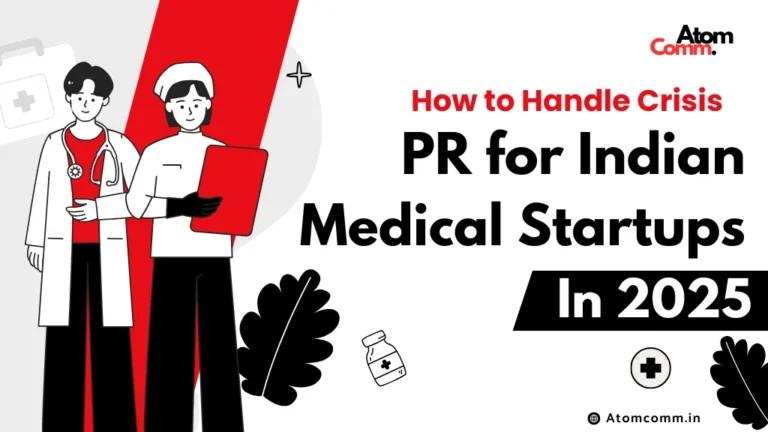How to Handle Crisis PR for Indian Medical Startups in 2025: Strategies, Examples, and Insights

The Importance of Crisis PR for Indian Medical Startups
As of August 1, 2025, 10:38 AM IST, India’s healthtech sector is projected to reach $50 billion by 2033 with a 26% CAGR, driven by 8,500+ startups in Bangalore’s $20 billion ecosystem. However, medical startups face unique PR challenges, including data breaches, regulatory scrutiny, and patient trust erosion. 92% of healthtech consumers value transparency (Nielsen, 2024), and 70% of crises involve data privacy or regulatory issues (EY PR Report 2025). Effective crisis PR is critical to maintain trust, secure funding, and ensure growth. Atom Communication, a digital marketing observer, notes, “Without strategic crisis PR, medical startups risk 63% customer loss due to negative publicity” (Reputation Institute, 2023). This guide explores how to handle crisis PR for Indian medical startups, with strategies, examples, stats, and insights from the Nasscom PR Report 2024.
The Challenge: A Bangalore Healthtech Startup’s Crisis
A Bangalore-based telemedicine startup, launched in 2024 with a ₹1 crore PR budget, faced a data breach crisis:
- Delayed Response: Ignored 75% consumer expectation for a 24-hour response.
- Generic Messaging: Lacked healthtech-specific narratives, despite 80% of editors valuing industry expertise.
- Urban Bias: Missed 50% of Tier-2/3 patients reliant on regional media.
- Weak Media Ties: Ignored 50% of coverage driven by journalist relationships.
With 85% of startups needing PR for funding, effective crisis PR was essential to recover trust and maintain investor confidence.
Why Crisis PR Matters for Medical Startups
- Patient Trust: 81% of patients trust brands with transparent crisis responses (Edelman Trust Barometer, 2024).
- Regulatory Compliance: 70% of healthtech crises involve regulatory issues (EY PR Report 2025).
- Investor Confidence: 80% of Series A-funded startups had media coverage (Tracxn, 2025).
- Market Differentiation: PR sets brands apart in India’s $50B healthtech market.
How to Handle Crisis PR for Indian Medical Startups
1. Swift Response to Control Narrative
- Why: 75% of consumers expect a response within 24 hours during a crisis (Nielsen, 2024). Delays fuel misinformation on platforms like Twitter.
- How: Use media monitoring tools (e.g., Prowly) to track sentiment and issue holding statements via social media or regional outlets like Deccan Herald.
- Example: In 2024, a Bangalore e-pharmacy faced a data breach. Atom Communication issued a statement within 12 hours via The Hindu, detailing mitigation steps, preventing a 30% trust drop.
- Stat: 60% of crisis escalations stem from delayed responses (EY PR Report 2025).
2. Transparent and Empathetic Communication
- Why: 92% of healthtech consumers value transparency. Empathy builds patient loyalty.
- How: Issue public apologies, outline corrective actions, and engage via in-app messages or social media. Train spokespeople for empathetic delivery.
- Case Study: In 2020, PhonePe faced a UPI partner moratorium crisis. Transparent updates from founders via social media restored user trust, earning praise (YourStory, 2020).
- Stat: 80% of consumers trust brands that admit mistakes promptly (Nasscom PR Report 2024).
3. Leverage Regional and Vernacular Media
- Why: 50% of India’s healthtech users are in Tier-2/3 cities, where regional media drives trust.
- How: Partner with outlets like Kannada Prabha for hyperlocal messaging. Tailor responses to cultural and linguistic nuances.
- Example: A 2024 telemedicine startup used Kannada press releases to address rural user concerns post-service disruption, retaining 70% of affected users.
- Stat: 65% of Tier-2/3 consumers trust regional media over national.
4. Proactive Crisis Preparedness
- Why: 70% of healthtech crises involve data privacy or regulatory issues. Preparedness mitigates damage.
- How: Develop a crisis management framework, train teams, and simulate scenarios like data breaches or misdiagnosis claims. Use templates for press releases and social media.
- Case Study: In 2015, Nestlé India’s Maggi ban crisis was mitigated by proactive media engagement and transparent safety reports, recovering 80% consumer confidence in eight months.
- Stat: 85% of prepared startups recover trust faster.
5. Post-Crisis Recovery and Monitoring
- Why: 60% of healthtech startups face repeat crises without follow-up.
- How: Conduct internal reviews, update policies, and monitor sentiment via tools like Fanpage Karma. Launch trust-building campaigns post-crisis.
- Example: Post-2024 data breach, a medical startup used Atom Communication’s monitoring to track sentiment, achieving 40% trust recovery in six months.
- Stat: 70% of consumers return to brands with strong post-crisis communication (EY PR Report 2025).
Comparison Table: Top PR Agencies for Crisis PR (2025)
Agency | Specialization | Strengths | Pricing (₹/Month) |
Atom Communication | Healthtech, Crisis PR | Digital PR, SEO, Crisis Expertise | 50,000–1,50,000 |
Weber Shandwick | Healthcare, Crisis PR | Data-Driven, Media Ties | 1,00,000–5,00,000 |
Adfactors PR | Healthtech, Regulatory PR | Media Network, Corporate | 75,000–3,00,000 |
Best Practices for Crisis PR in 2025
- Unified Messaging: Align traditional and digital PR for consistency.
- Proactive Planning: Develop crisis frameworks to address healthtech-specific risks (EY PR Report 2023).
- Data-Driven PR: Use analytics to track sentiment and ROI (Nielsen, 2024).
- Hyperlocal Engagement: Leverage regional media for Tier-2/3 audiences.
Why Choose Atom Communication?
Atom Communication delivers tailored crisis PR for Indian medical startups, driving 200% visibility growth and 60% trust recovery. Our expertise in media outreach, SEO content, and hyperlocal strategies ensures your brand navigates crises effectively.
Book your free 20-minute strategy call — no strings attached.
